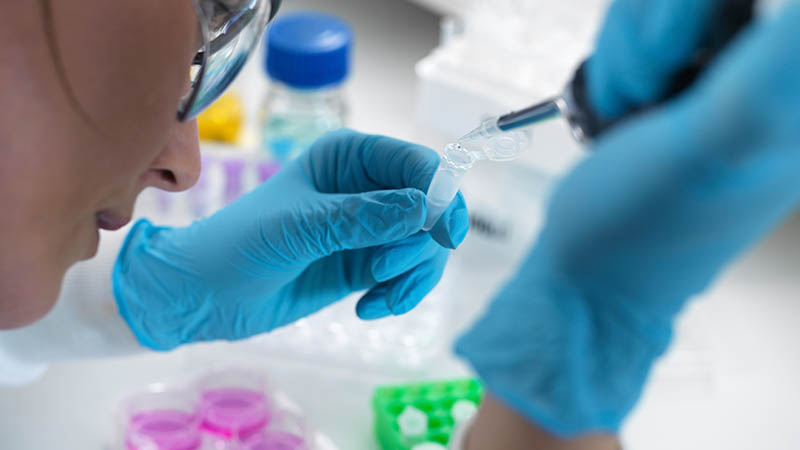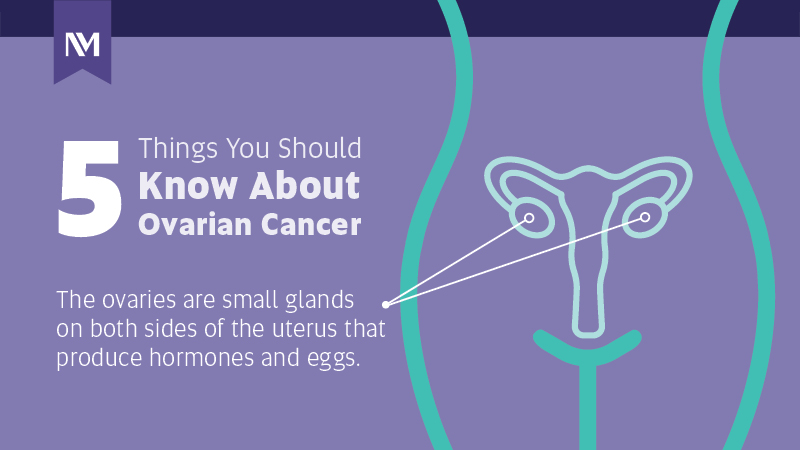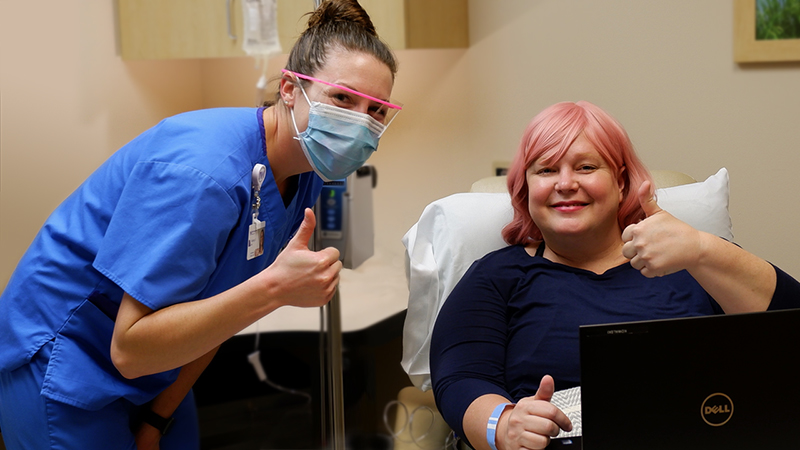Causes and Diagnoses
Causes and Diagnoses of Ovarian Cancer
The exact cause of ovarian cancer is unknown, but certain factors can increase a women's risk of developing this type of cancer. Risk factors include:
- Family history: A mother or sister with a history of ovarian cancer. If you have two or more first-degree relatives who have had ovarian cancer, this suggests that heredity may be a cause. If you have a family history of breast, ovarian, endometrial, or colon cancer, or genetic cancer syndromes such as Lynch syndrome, your family may have certain genetic mutations (such as BRCA genes) that increase the risk for ovarian cancer. These types of ovarian cancer account for about 10 percent of all ovarian cancer cases.
- A history of breast or colon cancer: A personal history of breast, uterine, rectum or colon cancer puts you at increased risk for ovarian cancer. Mutations in the BRCA 1 or 2 genes place a woman at a higher risk for breast and ovarian cancer.
- Over 60 years of age: The older you are, the greater your risk for getting ovarian cancer. A woman's risk for ovarian cancer rises with age and peaks during her 70s.
- No pregnancies or children: Women who have never borne children are at slightly increased risk for ovarian cancer.
- Obesity: Being obese, or having a body mass index greater than 30, increases risk for ovarian cancer. The more excess weight you have, the more your risk increases.
- Talcum powder use: This is a controversial subject. Some studies show a relationship between ovarian cancer and use of talcum powder on the genital area. This may be because this powder once contained asbestos. For more than 20 years, however, the law has required these powders to be free of asbestos.
- Long-term estrogen replacement therapy: If you've used menopausal estrogen replacement therapy (taking estrogen alone, without progesterone) for more than 10 years, you may have a slightly increased risk of ovarian cancer.
- Fertility drugs: If you've used fertility drugs, you may be at increased risk for ovarian cancer. Research studies have produced conflicting results.
- Endometriosis: If you have endometriosis, a painful condition where endometrial tissue is found outside the uterus, you may be at increased risk for ovarian cancer.
- Maintaining a healthy diet that's high in fruits, vegetables and grains and low in saturated fat
- Maintaining a healthy weight
- Pregnancy and breastfeeding
Reducing your risk
Women who are high-risk of developing ovarian cancer because of family history may wish to consider risk reduction measures, which may include:- Oral contraceptives: Women who use birth control pills for at least five years are three times less likely to develop ovarian cancer.
- Tubal ligation: Permanent forms of birth control such as tubal ligation reduce the risk of ovarian cancer by 50 percent.
- Removal of ovaries: Women with an extensive family history of breast or ovarian cancer, or who carry altered versions of the BRCA genes, may opt for a prophylactic oophorectomy to remove both ovaries, lowering the risk of ovarian cancer by up to 80 percent.
Diagnoses
A diagnosis of ovarian cancer begins with a complete medical history, including your family history, reproductive history and a physical examination. Additional diagnostic testing may include:
- Pelvic exam: This exam allows your physician to feel for any unusual masses (lumps) or other problems. During a pelvic exam, you lie on your back on an exam table, with your feet in stirrups. Your physician inserts one or two fingers of a gloved hand inside your vagina and uses the other hand to press on your lower abdomen (belly) to feel for masses. Your physician may also insert a finger in your rectum to feel for anything unusual that might suggest that the cancer has spread. The pelvic exam may include a Pap test, in which cells taken from the cervix or vagina to look for changes that show cancer or conditions that may develop into cancer.
- Ultrasound: This test allows your physician to see if a cyst or tumor is present. The physician aims sound waves at your ovaries either by inserting a small probe into your vagina (called a transvaginal ultrasound) or aiming them at the surface of your abdomen (called an abdominal ultrasound). The pattern of the echoes makes a picture, called a sonogram, on a video screen. The echoes are different for healthy tissues, fluid-filled cysts and tumors. The test can be uncomfortable, but is not painful, and you don't need sedation.
- Computed tomography (CT scan): This test uses a combination of X-rays and computer technology to make pictures of organs and tissues in the pelvis or abdomen. You may be given contrast material by mouth and by injection into your arm or hand. The contrast material helps the organs or tissues show up more clearly. The CT scan may indicate enlarged lymph nodes, a possible sign of a spreading cancer or infection.
- Lower gastrointestinal (GI) series: Also called a barium enema X-ray, this is a series of X-rays of the lower intestine. The barium solution outlines the intestine on the X-rays and any areas blocked by cancer. The test is usually not part of an evaluation for ovarian cancer, but may be used to see if cancer has spread into the lower intestine or rectum.
- Intravenous pyelogram (IVP): This is a set of X-rays of the kidneys and ureters, taken after the injection of a dye, to determine if cancer has spread to the urinary tract.
- CA-125 Blood test: This blood test shows how much of a protein called CA-125 is in your blood. An elevated CA-125 may indicate the presence of tumor cells, but it also can be elevated in many non-cancer conditions. After a diagnosis of ovarian cancer, your physician may use this blood test to see whether you are responding to treatment, or if the cancer has come back. This test is usually combined with an ultrasound.
- Biopsy: In this procedure, tissue samples are removed from the ovary for examination under a microscope. A biopsy is rarely used to diagnose ovarian cancer. If tumors are identified in any earlier tests, the next step is usually surgery.
- Surgery: In surgery, a surgeon removes the tumor or tumors and takes samples of surrounding tissues. In a lab, a pathologist examines the removed cells to determine if cancer is present or has spread.




